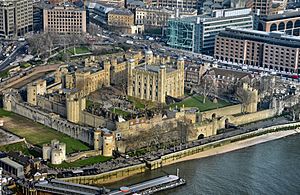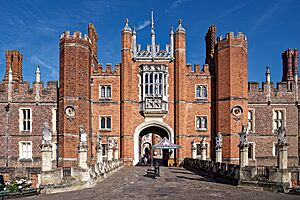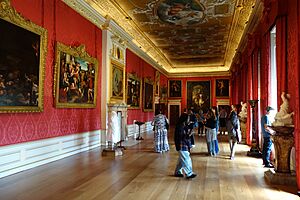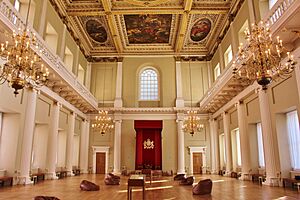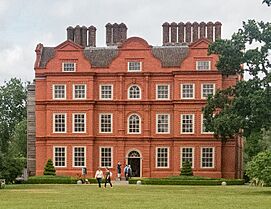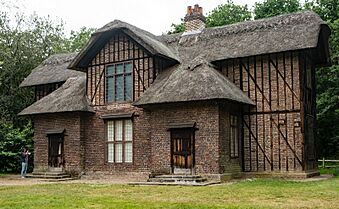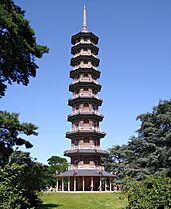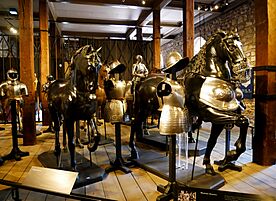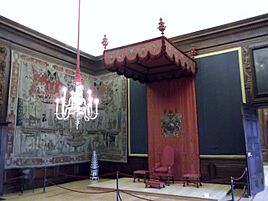Historic Royal Palaces facts for kids
 |
|
| Abbreviation | HRP |
|---|---|
| Formation | 1989 |
| Legal status | Royal Charter Body |
| Headquarters | Hampton Court Palace |
| Location |
|
|
Region served
|
England and Northern Ireland |
|
Membership
|
167,799 (2023-24) |
|
Chair
|
Nicholas Coleridge |
|
Chief Executive Officer
|
John Barnes |
|
Main organ
|
Board of Trustees |
|
Revenue
|
£134.4 million (2023–24) |
|
Staff
|
833 FTE (2023–24) |
|
Volunteers
|
800 |
Historic Royal Palaces is a special charity in the United Kingdom. It looks after royal palaces that are no longer used by the King or Queen.
These amazing places include:
- The Tower of London
- Hampton Court Palace
- The State Apartments and Orangery at Kensington Palace
- The Banqueting House, Whitehall
- Kew Palace with Queen Charlotte's Cottage and Great Pagoda at Kew Gardens
Historic Royal Palaces also takes care of Hillsborough Castle in Northern Ireland. This castle is the King's official home when he visits Northern Ireland.
This charity has managed the London palaces since 1989. They started looking after Hillsborough Castle in 2014. Other royal palaces, like Buckingham Palace and Windsor Castle, are still used by the Royal Family. These are looked after by the Royal Household.
Contents
What Historic Royal Palaces Does
Historic Royal Palaces is a charity set up by a special document called a Royal Charter. This means it has official permission from the King to do its work.
The main goals of Historic Royal Palaces are:
- To keep the palaces in great condition. They make sure these historic buildings, which have royal connections, are well-preserved.
- To help everyone learn about the palaces. They do this by letting people visit, creating exhibitions, holding events, and running education programs. They also do research and publish information.
Historic Royal Palaces does not get money from the government or the King. It earns all its own money to pay for everything it does.
The King owns the London palaces. Historic Royal Palaces has a contract with the government to manage these five London palaces for him. Hillsborough Castle is owned by the government. Historic Royal Palaces manages it for the government too.
The charity has a business part called Historic Royal Palaces Enterprises Limited. This company runs shops and other activities to help the charity earn money.
How the Charity is Run
A group of people called the Board of Trustees leads Historic Royal Palaces. There is a Chair and eleven Trustees. They are not paid for this job. The King chooses the Chair. Some Trustees are chosen by the King, and others by a government minister.
The Chief Executive is in charge of the daily running of the charity. The current Chief Executive is John Barnes. He has been in this role since 2017.
Exploring the Palaces
Historic Royal Palaces looks after several amazing historic sites. Each one has its own unique story.
Tower of London
The Tower of London is a very old castle next to the River Thames in London. It was built way back in 1066 after the Norman Conquest. The famous White Tower was built by William the Conqueror in 1078.
Over the years, the Tower of London has been many things. It was a place to store weapons, a treasury, a prison, and even a zoo! It also housed the Royal Mint (where coins were made) and the Crown Jewels of England. The Tower is a group of buildings with two strong walls and a moat (a ditch filled with water) around them.
When you visit the Tower, you can see the sparkling Crown Jewels. You can also meet the famous Tower Ravens. Exploring the White Tower and walking along the old battlements is a great experience. You can also visit St John's Chapel.
Hampton Court Palace
Hampton Court Palace is a historic royal home by the River Thames in London. Cardinal Wolsey started building it in 1514. Then, Henry VIII took it over and made it even bigger. It became a very important place for royal power during the Tudor period.
Later, during the time of William III, the palace was updated in the fancy Baroque style. Christopher Wren designed these changes. Queen Victoria opened the palace to the public in 1838.
Historic Royal Palaces calls Hampton Court Palace the "home of Henry VIII." Visitors can learn about the exciting lives of Henry VIII, his wives, and their children. You can also explore the beautiful Baroque palace and its 60 acres of gardens. There's even a Magic Garden adventure playground!
Kensington Palace State Apartments
Kensington Palace is a royal home located in Kensington Gardens in London. The State Apartments were updated in the late 1800s and opened to visitors.
Historic Royal Palaces highlights Kensington Palace as the birthplace and childhood home of Queen Victoria. You can see the Jewel Room, which holds jewelry ordered by Queen Victoria. The Queen's and King's State Apartments are also key attractions. The Orangery at the palace is now a cafe and restaurant.
The Banqueting House, Whitehall
The Banqueting House is in Whitehall, central London. It is the only large part left of the old Palace of Whitehall. It is a beautiful example of a banqueting house built in the classical Palladian architecture style.
The main thing to see at the Banqueting House is the amazing decoration of the Banqueting Hall. This includes the ceiling painting by Rubens, which was ordered by Charles I. Historic Royal Palaces also points out that this was where King Charles I was executed.
Kew Palace and its Gardens
Kew Palace is a historic palace inside Kew Gardens in London. Queen Charlotte's Cottage is an 18th-century country-style house also in Kew Gardens. The Great Pagoda was built in 1761 by Sir William Chambers. It was a gift for Princess Augusta, who started Kew Gardens.
Historic Royal Palaces promotes Kew Palace as the home of George III and Queen Charlotte. The Royal Kitchens are a popular place to visit.
Hillsborough Castle
Hillsborough Castle is in Royal Hillsborough, County Down, Northern Ireland. It is the official home for the government minister for Northern Ireland. It is also where the British monarch and other members of the British royal family stay when they visit the area. Important international visitors also stay here.
Historic Royal Palaces highlights the beautiful 100-acre gardens and the castle's State Rooms as main attractions.
Royal Collections
Historic Royal Palaces also looks after many important historical items. These are called "heritage assets."
Some of the main collections include:
- The Royal Ceremonial Dress Collection: This has about 11,000 items of British royal and court clothing. It includes famous dresses like the Travolta Dress. This collection started at Kensington Palace in 1984.
- The general collection: This has about 10,000 items. It includes paintings, drawings, furniture, sculptures, and decorative art. These are mostly shown inside the palaces.
- Architectural drawings archive: This has about 22,000 drawings, both old and new. These drawings show how the palaces have changed over time.
- Architectural and archaeological materials: These are items found or dug up from the palaces. They are used for research.
Historic Royal Palaces also displays items that are on loan from other places. These include:
- Artworks from the Royal Collection: These are owned by the King for the nation.
- Arms and armor at the Tower of London: These belong to the Royal Armouries.
- Art and other items at Hillsborough Castle.
- A collection of jewelry linked to Queen Victoria, on display at Kensington Palace.
How Historic Royal Palaces Earns Money
Historic Royal Palaces is a public organization. But it does not get money from the government or the King. It earns all its own money.
| Historic Royal Palaces
Visitor figures 2024 |
|
|---|---|
| Tower of London | 2,902,385 |
| Hampton Court Palace | 702,918 |
| Kensington Palace | 413,588 |
| Kew Palace | 159,102 |
| Hillsborough Castle | 109,639 |
| Banqueting House | 1,274 |
The charity makes money in several ways. These include ticket sales, memberships, donations, shop sales, and other business activities. In the year ending March 31, 2024, Historic Royal Palaces earned £134.4 million. More than half of this (£84.9 million) came from ticket sales. The Tower of London alone brought in £66.2 million from tickets.
Membership fees from its 167,799 members added £5.6 million. Sales from gift shops and online stores brought in £20 million. Events and functions raised another £6.8 million.
The charity spends its money on two main things: 'Costs of raising funds' and 'Expenditure on charitable activities'. In the year ending March 31, 2024, the total spending was £90.9 million. Of this, £73.9 million went to charitable activities. This included £25.5 million for looking after the Palaces (like conservation work and maintenance). £41.4 million was spent on 'Experiences' (like exhibitions, special events, and school programs).
A Look at the History
How the Palaces Were Managed Before
In the 1800s and early 1900s, a government department called the Office of Works started looking after the unoccupied royal palaces in London.
Hampton Court Palace had informal tours since the time of Queen Elizabeth I. By the 1700s, people could arrange tours. The palace officially opened to the public in November 1838.
The Tower of London was managed by the War Office for a long time. In 1903, the Tower, its military buildings, staff, and tourist income were fully moved to the Office of Works.
Kew Palace and Queen Charlotte's Cottage were also moved to the Office of Works. In return, the run-down Kensington Palace was renovated. Its State Apartments were then opened to the public.
The Start of Historic Royal Palaces
In 1970, the government department that managed public buildings changed. Later, in 1984, a new group called English Heritage was created. This group took over managing many historic buildings outside of direct government control.
However, the government did not want the royal palaces to be part of this change. They worried it might look like the palaces were being sold off. But a big fire at Hampton Court Palace in 1986 showed that the way the buildings were managed needed to improve.
After some changes, the unoccupied palaces were moved out of government control. On October 1, 1989, they became a special agency called Historic Royal Palaces. It was run like a business. In 1998, Historic Royal Palaces became an independent charity. It signed a contract with the government to manage the London palaces for the King. In 2014, it also started managing Hillsborough Castle.
Historic Royal Palaces During the COVID-19 Pandemic
When the COVID-19 pandemic started in early 2020, fewer people visited the palaces. On March 20, all Historic Royal Palaces sites closed. Most staff were temporarily sent home. The charity used its savings to survive.
Historic Royal Palaces received a £3 million grant to help with conservation projects. In January 2021, they also got a £40 million loan. Income for the 2020-21 financial year dropped a lot, to £12 million. Sadly, 284 staff members lost their jobs.
In 2023, Historic Royal Palaces started working with the University of Manchester. They are supporting a research project about the British monarchy's links to slavery. This study is expected to finish by 2026.
See Also
- Collections maintenance
- Conservation and restoration of historic gardens
- Cultural heritage management
- Cultural property exhibition
- List of British royal residences
- Tales from the Palaces


